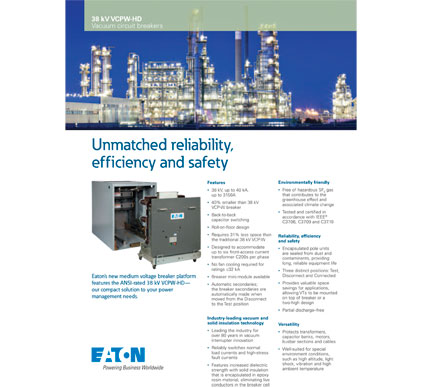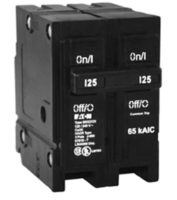 New, compact medium-voltage circuit breaker platform is designed to improve power reliability, efficiency, and safety.
New, compact medium-voltage circuit breaker platform is designed to improve power reliability, efficiency, and safety.
Eaton Corporation has introduced the VCPW-HD medium voltage vacuum circuit breaker that is designed for utility, industrial, and commercial applications. The new 38 kilovolt (kV) circuit breaker is engineered to provide reliable and robust circuit protection in a compact, environmentally friendly, and reliable package.
The VCPW-HD breakers are designed to protect transformers, capacitor banks, motors, busbar sections, and cable. The compact medium-voltage circuit breakers are engineered to withstand demanding environmental conditions, and are suitable for high altitude, shock, vibration and high ambient temperatures.
“Eaton’s commitment to innovation is yielding breakthrough technologies for control and protection of power equipment,” said Jhula Barua, product manager at Eaton. “The new VCPW-HD circuit breaker platform has a compact design and incorporates industry-leading vacuum interruption and solid insulation technologies.
The VCPW-HD is engineered to reliably switch normal load currents and high-stress fault currents. The compact, modular design has dielectric strength with solid insulation that is encapsulated in epoxy resin material, eliminating live conductors in the breaker cell.
The VCPW-HD circuit breakers incorporate Eaton’s vacuum interrupting technology, which avoids the use of Sulfur Hexafluoride (SF6) gas that contributes to the greenhouse effect and is associated with climate change. For increased durability, performance and compactness, the Eaton vacuum interrupters are encapsulated in epoxy resin, protecting them from mechanical impact and environmental conditions such as humidity and dust, and require virtually no maintenance over the product lifecycle.
Eaton’s new 38 kV VCPW-HD circuit breakers provide current ratings up to 3000 amperes without fan cooling and up to 40 kilo amperes. They meet American National Standards Institute (ANSI) and Institute of Electrical and Electronics Engineers (IEEE) C37.06, C37.09, and C37.10 standards.


